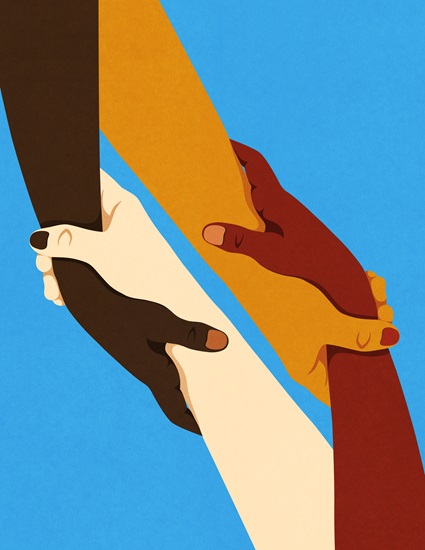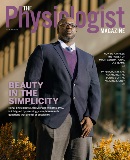How to Be a Great Ally
Learn how to support and lift up colleagues—without doing harm.
By Mike De Socio

Clintoria Williams, PhD, is used to hearing a certain comment from people in her field: Academic programs often don’t include Black students because there simply aren’t enough Black applicants in the first place.
Williams, an associate professor and director of the small animal physiology core at Wright State University in Dayton, Ohio, sees this as a prime opportunity for an ally to jump in and ask a critical question: Why are they not applying?
“Because talent is everywhere; we just have to be willing to put in the extra effort to find it,” Williams says.
There’s another comment that usually follows: Even when Black students do apply, their applications are not competitive. “An ally is someone that is in the room using their voice to say, ‘OK, this is happening, but why? What can we do to enhance this situation?’” she says.
Williams, as a Black woman in physiology, sees these types of conversations unfold all the time and says they illuminate the important role of white and other non-marginalized allies in science: to be a champion for underrepresented groups when they have the power to do so.
“In order to be an ally, you have to be willing to use your voice and to also use your scientific currency to bring awareness to some of the biases, even when it may not be an easy or popular thing to do in that room,” Williams says.
The desire to be an ally has been on the minds of countless scientists over the past two years, as the COVID-19 pandemic and Black Lives Matter movement brought new awareness to social justice issues across society. But exactly how to be a great ally—without overstepping or creating more harm—is a challenge that has left many scientists afraid to take action.
Edward Merritt, PhD, an associate professor of kinesiology at Southwestern University in Georgetown, Texas, remembers feeling that discomfort when he first got involved as a white man in diversity, equity and inclusion (DEI) work. Merritt is a member of the APS DEI Committee.
“I’m stepping in as this random guy who knows about skeletal muscle research and that’s about it,” he says. “I just feel like, ‘oh gosh, I don’t know, what is my role here?’”
Merritt has since gained some perspective, and along with Williams and other experts, has a few ideas. Here’s your guide to being a great ally to people in underrepresented communities, including people of color, women, LGBTQ+ people or people with disabilities.
Speak Up and Step Up
First things first: What exactly is an ally? James Pogue, PhD, president and CEO of the DEI consulting firm James Pogue Enterprises, says it’s important to start with definitions.
Most allies fall into this category: “You’re a part of the majority group, aligned with and helping to advance the equity and equality of the underrepresented group,” he says. But there’s another type of ally: You’re part of one marginalized group—the LGBTQ+ community, for example—and you’re helping colleagues in a different marginalized group, such as the Latino community.
Fundamentally, allies are using their relative power to advocate for a group that is not their own. That’s the first step: Learning to speak up, and step up, even when it’s uncomfortable.
“If you aren’t a part of that group, you probably have a privilege they don’t have,” says Jesse Moreira, PhD, MS, a postdoctoral fellow in cardiovascular medicine at Boston University School of Medicine. “Realizing the privilege you may have makes you a better ally because it allows you to leverage that privilege to lift up the voices of that community.”
As Williams points out in conversations related to diversity of applicants, it sometimes takes a white scientist with more power to challenge the status quo and get others to listen. This is a role that Moreira often embraces, as a white, queer and nonbinary person in science. They sometimes push back on others in the field who don’t see the need for diversity-specific fellowships, for example.
Merritt knows he occupies this role, too, but he tries to toe a fine line when he does speak up. “I don’t want to be dictating any of this, but I want people to know that I’m on their side and I’m willing to help,” he says.
“We have to do more than have happy words. We have to do the hard work of assessing, seeing where we are, measuring where we are, setting a goal way out there, and then let’s go get it.”
James Pogue, PhD
He often faces skepticism about why he, as a white man, is even on a DEI committee. But Merritt says he can help shoulder some of the burden of this work: It’s not fair for the few underrepresented professors to do all of the unpaid additional labor of DEI work on top of their faculty roles, he says.
It’s important to remember: Though DEI might not be your expertise, don’t let the fear of messing up stop you from taking action. “As long as the intention is there, you have to give credit,” Williams says. “It’s not easy; it’s not easy to speak up. You have to respect the person who’s willing to.”
Speaking up, however, need not be relegated only to DEI meetings or employee resource groups. Merritt says he often has more success bringing up these topics when they’re weaved into an existing scientific discussion. If he’s giving a talk about his expertise of muscle science, for instance, he might mention his experience working with Black patients whose skepticism of him as a part of the medical establishment comes from a history of medical racism.
“We can just add these little things into our classes, into our research talks, that just put that little bug in their head,” Merritt says.
Lift As You Climb
If you’re not sure where to start as an ally, Keisa Mathis, PhD, has a suggestion: “The easiest thing to do is to take a look, think about your own life and your own career path and what it took to get where you are now,” she says. “And then realize there may be different people behind you and they possibly will need that same help.”
Mathis is an assistant professor of physiology and anatomy at the University of North Texas, Health Science Center at Fort Worth. As a Black woman, Mathis recognizes the many times when an ally did—or didn’t—step up to help advance her academic career.
She’s now trying to pay it forward, and she’s not waiting to be asked for help; she’s taking the initiative. She’s currently working with an undergraduate student from her hometown who’s applying for medical school, helping her polish her application. And she’s advising a new Black faculty member in her department, hoping she can pass along some of the lessons she’s learned.
Another opportunity is at scientific meetings and networking events, where it can be intimidating to break into conversations if you’re the “only one in the room” of any particular group. An ally, Williams says, is someone who’s aware of that power imbalance and goes out of their way to engage that person and bring them into the fold.
Again, both Williams and Mathis say it’s important that you don’t let fear hold you back from offering this type of allyship. “Any time you offer help to someone, they could either take it or not, and it’s not really ever a mistake, I don’t think, as long as it’s coming from a good place,” Mathis says.
You can also expand your idea of who needs help and support. “People should always think about others in different phases of their career,” Mathis says, noting that sometimes she still finds herself needing an ally. “The help is needed at all phases of the career, not just starting out, not just as an assistant professor, not just as a student.”
Measure Success
So you’ve joined the DEI committee. Maybe you’re mentoring a young student or professor. You’re speaking up for underrepresented groups. Now what?
This is where a lot of well-intentioned allies drop the ball, according to Pogue, because they don’t set clear goals or measurements for success. “Allyship in many ways, while it is action-based, it has been unfortunately absent of strong policy,” Pogue says.
For this work to succeed long term, Pogue says allies need to make a series of difficult decisions: Which marginalized groups will receive your attention and resources? What metrics will you look at to gauge progress and on what timeline? Who will be responsible for these outcomes?
“We have to do more than have happy words,” Pogue says. “We have to do the hard work of assessing, seeing where we are, measuring where we are, setting a goal way out there, and then let’s go get it.”
Here’s an example of setting a goal backed by strong policy: A professor might have three hours per month to offer mentorship. The department could then decide, for all professors with that amount of time to offer, that there’s a specific process to follow: All mentors will go through inclusivity training and a rigorous approval program, so that by the time they go to offer their three hours of mentorship, that time will be a lot more valuable.
This type of process and measurement, Pogue says, should not be alien to academics and scientists. In fact, they should treat allyship much the same way they treat the rest of their work. “We have not held the diversity space up to the same level of rigor as we do everything else,” Pogue says.
This article was originally published in the November 2022 issue of The Physiologist Magazine.
“The easiest thing to do is to take a look, think about your own life and your own career path and what it took to get where you are now. And then realize there may be different people behind you and they possibly will need that same help.”
Keisa Mathis, PhD
The Physiologist Magazine
Read the Latest Issue
Don’t miss out on the latest topics in science and research.
View the Issue Archive
Catch up on all the issues of The Physiologist Magazine.
Contact Us
For questions, comments or to share your story ideas, email us or call 301.634.7314.
Quick Tips for Allyship
Initiate the conversation. Speak up in meetings to ask hard questions. Engage underrepresented folks and make sure they’re part of the discussion. “It’s difficult to break into certain groups, and it’s intimidating too,” Clintoria Williams, PhD, says.
Don’t forget about policies and procedures. Your diversity, equity and inclusion (DEI) initiatives deserve the same scientific rigor as the rest of your work. Make sure you’re measuring success and being critical about what works—and what doesn’t. “We need to engage in some structural pieces that will outlive us,” DEI expert James Pogue, PhD, says.
Offer help before you’re asked. People at all levels of their career need allyship; don’t wait until you’re asked. “Think about how citing a person’s work or adding them to a grant could benefit their careers, and reach out to them,” Keisa Mathis, PhD, says.
Don’t keep DEI in a silo. Be aware of how your field of study intersects with any DEI issues. Integrate that into your work and your classroom. “That’s where I hope I can contribute the most, is just these little changes,” Edward Merritt, PhD, says.


